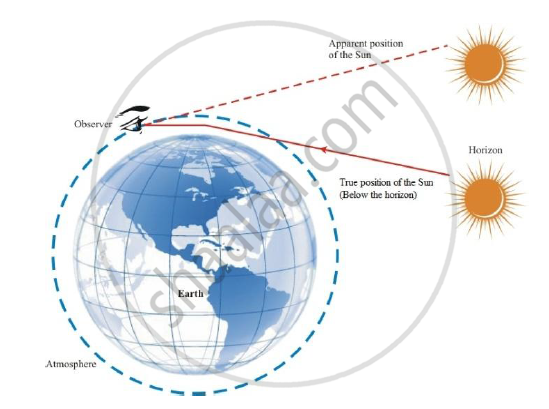Advertisements
Advertisements
प्रश्न
What is atmospheric refraction? Use this phenomenon to explain the following natural events:
Advanced sun-rise and delayed sun-set.
Draw diagrams to illustrate your answers.
उत्तर
The sunrise is advanced because of the atmospheric refraction of sunlight. An observer on the Earth sees the Sun two minutes before the Sun reaches the horizon. A ray of sunlight entering the Earth's atmosphere follows a curved path because of atmospheric refraction before reaching the Earth. This happens because of a gradual variation in the refractive index of the atmosphere. For an observer on the Earth, the apparent position of the Sun is slightly higher than the actual position. Hence, the Sun is seen before it reaches the horizon.

The increased atmospheric refraction of sunlight occurs also at sunset. In this case, the observer on the Earth continues to see the setting Sun for two minutes after the Sun has dipped below the horizon, thus delaying the sunset. The advanced sunrise and delayed sunset increase the duration of the day by four minutes.
APPEARS IN
संबंधित प्रश्न
Explain why the planets do not twinkle.
Atmospheric refraction causes advance sunrise and delayed sunset. By how much time is:
sunset delayed?
Fill in the following blank with suitable word:
We can see the sun about ................ minutes before the actual sunrise and about ................ minutes after the actual sunset because of atmospheric ................
What is atmospheric refraction? What causes atmospheric refraction?
The stars twinkle but the planets do not twinkle at night because:
(a) the stars are small but the planets are large
(b) the stars are very large but planets are small
(c) the stars are much nearer but planets are far off
(d) the stars are far off but planets are nearer to earth
Due to atmospheric refraction of sunlight, the time from sunrise to sunset is lengthened by about:
(a) 6 minutes
(b) 2 minutes
(c) 4 minutes
(d) 5 minutes
A student claims that because of atmospheric refraction, the sun can be seen after it has set, and the day is, therefore, longer than if the earth had no atmosphere.
Do you think that the students conclusion is correct?
Explain why the planets do not twinkle but the stars twinkle.
The air layer of the atmosphere whose temperature is less than the hot layer behave as optically:
Assertion: Sky appears blue in the day time.
Reason: White light is composed of seven colours.
